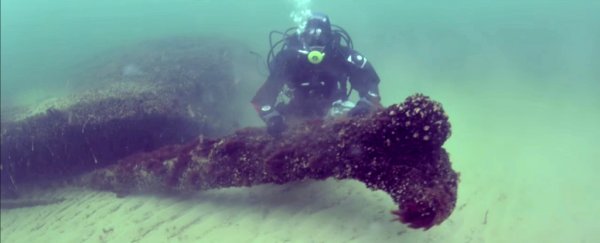If you want to study ancient human civilisations, you might want to start by getting a diving certification, because many now lie underwater, thanks to our warmer climate.
One of the most intriguing of these communities dates back to the Neolithic, or New Stone Age, period, and lies totally submerged, around 20 metres (65 feet) below sea level in Hanö Bay, off the southern coast of Sweden.
The 9,000-year-old settlement was first discovered seven years ago, but has just been mapped by scientists from Lund University in Sweden.
The settlement existed at crucial time in human history, and the researchers hope that by understanding who lived there, and how they lived, they'll get some insight into how humans conquered the globe.
"If you want to fully understand how humans dispersed from Africa, and their way of life, we also have to find all their settlements," said team member Anton Hansson.
"As geologists, we want to recreate this area and understand how it looked. Was it warm or cold? How did the environment change over time?"
In the video below, you can watch as researchers explore the incredible settlement, which remains unnamed:
Although it seems weird for an ancient settlement to end up underwater, it's actually not that uncommon, seeing as humans favour living near the coast - leaving their homes vulnerable to being swallowed up as sea levels rise.
"Quite a few of these [settlements] are currently underwater, since the sea level is higher today than during the last glaciation. Humans have always preferred coastal sites," explains Hansson.
Other than natural sea level rise, quite a few other settlements have sunk into the ocean thanks to other powerful geological events.
For example, the Greek island of Santorini was once a larger island in the Aegean Sea, and home to Akrotiri, a Late Bronze Age outpost of Minoan civilisation, which preceded ancient Greece.
But in the 17th century, a nearby volcanic explosion triggered a tsunami that wiped the Akrotiri civilisation off the map, and broke Santorini into a few smaller islands – an event that researchers are still studying to this day.
When Stone Age humans lived at site the Lund University team is currently studying some 9,000 years ago, geologists think it was home to a lagoon, making it popular for fishermen. That hypothesis is backed up by a series of extremely well-preserved fishing traps found at the site.
Besides the fishing traps, the team has also uncovered a 9,000-year-old pickaxe made from elk antlers, and have successfully taken samples sediment for radiocarbon dating.
Currently, the team has just completed a bathymetrical (or depth) map of the region, allowing them to better understand how the area might have looked when humans lived there.
Even with so much data already recorded, there are still a lot of unanswered questions about the settlement's inhabitants. Did they live there year-round? Was fishing their primary way of life?
As the careful excavation continues, more details will be exposed, but until then, at least we have some awesome footage to hold us over.
The team's work was published in Quaternary International.
